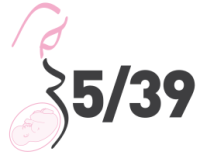Trial Summary
Who can take part in the 35/39 trial?
Women who are pregnant with their first baby and who will be 35 years of age by the time of their expected date of delivery can take part. They must be having a single baby and the baby must be ‘head down’ (cephalic presentation), which means the baby’s head has entered their pelvis.
Why is it called the 35/39 trial?>
We wanted the title to remind doctors and patients of the eligibility criteria (age over 35 years) and the weeks at which the intervention group were being offered labour induction (39 weeks).
Who is eligible?
Before a woman can take part in the trial they will have to meet certain criteria:
- Pregnant with their first baby / nulliparous (no previous pregnancies beyond 24 weeks)
- Over 35 years of age at the expected date of delivery
- Pregnant with a single baby
- A cephalic presentation ('head down')
- Gestational age between 360/7 and 390/7
- No medical reason why they cannot have their labour induced
- No medical reason why the pregnancy could not be allowed to proceed to term plus 10 days
- Willingness to participate in the trial
- Written informed consent
Who is not eligible?
- Women with a known lethal fetal congenital abnormality.
- Women with a medical reason why they cannot have their labour induced or have a vaginal delivery (e.g. placenta praevia)
- Women with a medical reason for induction of labour prior to T+7
- Women with a previous myomectomy (operation to remove fibroids from the womb)
- Women who book late for antenatal care and have no dating scan performed before 22 weeks to provide an accurate EDD.
- Women who have undergone IVF using donor eggs in the current pregnancy
How many people do we need to take part in our study?
We need 630 women to take part to make sure the results are valid. We will recruit women at 12 participating sites across the UK over 2 years.
What are the treatments being tested?
We are comparing two ways of managing the pregnancies of women over 35 years of age, ‘induction of labour at 39 weeks’ or ‘no intervention’. Women in the induction of labour group will have their labour induced or started artificially at 39 weeks.
They will be allocated a date for induction and will come to the delivery suite that day. When they arrive the midwife will check the baby’s heartbeat and examine the woman’s cervix or ‘neck of the womb’ by performing an internal examination. Depending on whether the cervix is already opening up they will start labour either with a drug called prostaglandin administered through the vagina, or by breaking the waters and giving a drug called oxytocin by intravenous infusion (a drip).
Prostaglandins are inserted into the vagina in the form of a tablet, gel or a pessary by the midwife. If one dose doesn’t get a woman into labour then they may need repeating. Alternatively a slow release pessary may be used for 24 hours.
Amniotomy is where the midwife artificially breaks the waters during an internal examination. This may be done right at the outset of the induction, or after the prostaglandins have had a chance to soften and open the neck of the womb.
Labour induction may involve the use of a hormone called syntocinon, which causes the womb to contract; this is given through a ‘drip’ or a small tube, which sits in a vein that is inserted using a needle. The process of induction of labour will be exactly the same as that used in the hospital for all other women having their labour induced.
Women in the ‘no intervention’ group will await spontaneous labour unless a situation develops where their labour needs to be induced or they need a Caesarean section. They will be offered induction of labour anywhere between T+7 and T+14, the exact time to be determined by their consultant’s usual practice.
How long will the study go on for?
The trial will end once all data has been collected for the 630 participants or at two years whichever is the later time point.


